Jubilee Bridge cityscape, Singapore.
The 6-8 Dec. 2017 Global Production Networks (GPN) conference was held in Singapore, hosted by the National University of Singapore.
Text & Photo © JE Nilsson, CM Cordeiro 2017
Launched in Jan. 2015, the Global Production Networks Centre at the National University of Singapore (NUS) is home to a new research initiative that studies the role of global production networks (GPNs) in the development of Asia. Due to the comprehensive and complex nature of GPN studies, the centre hosts scholars from various cognate disciplines, some of which include sociology, economics, international business, human-economic geography and social psychology in view of cultivating an integral perspective to the GPN field of study. Rather than a more traditional double-blind peer review system to the submission of conference papers, the purpose of the Conference on Global Production (CGP) 2017, held between 6-8 Dec., was to facilitate network sessions and exchange of ideas of like minded individuals interested in GPN and global value chain (GVC) research.
CGP 2017 had several prominent keynote speakers, of which I personally found most interesting, the insights from Patrick Low, who is Profesor of International Economics, Program Director at the Asia Global Institute in Hong Kong and formerly Chief Economist at the World Trade Organisation (WTO) for 16 years until 2013. In a 2013 video interview by the Hong Kong Trade Development Council (HKTDC) [1], Low indicated the complexity of global value chains by referring to the cascading influences of digitization on mass consumption sectors, ”Consumers increasingly don’t want to just go to the shops, they probably don’t want to just do it online. They probably want both, so if you’re in that business you’ve got to worry about what your appropriate mix of clicks and bricks is that’s why this talk about an omni-channel and I think this is a very challenging issue for for supply chain operators”. Low continued to say that the services sector and its contribution to productivity continues to be poorly understood. Considering that services generates enormous economic activity, services are complex activities that need closer attention by policy-makers. In terms of the way forward for global trade, Low’s more recent article in the Asian Review [2] reflects a positive perspective, ”Globalization does not inevitably carry the seeds of its own demise. Rather, it is threatened by short-termism, sustained by a toxic narrative that masks the politics of blame and responsibility avoidance. Anti-globalization is primarily the product of political failure.” and that multilateralism is key to moving forward, being ”least difficult”. Low views that multilateralism is a preferred strategy due to that it does not coerce countries unprepared for particular commitments into acting on premature decisions.
CGP 2017 had 22 conference themes running in five parallel sessions held at the Shaw Foundation Alumni House at NUS. In address to the practical complexities of GPN activities, scholars have called for a holistic approach and integrated/dynamic theory towards the study of GPN-GVC. GPN scholars are not alone in their rallying call for unified or integrated theories of knowledge. Jørgen Ørstrøm Møller, Professor of Political Economics and formerly the Danish (1997-2005) ambassador to Singapore, described how big data, quantum computing and artificial intelligence is requiring of the education system to model inductive perspectives of knowledge acquisition, with a need for combining knowledges across disciplines in a deeper manner than what is currently achieved, ”The end goal should be systems or the use of current language models that adapt themselves. This is induction.” [3]. It was in address to this call for an integrated and dynamic theory to the scientific paradigm and in this case, GPN theory that I made these presentation slides in contribution to CGP’s track on ”Methodology in the study of global production networks”.
The presentation slides and (personal) notes are found below. The presentation was done on 7 Dec. at CGP 2017 under Reconfiguring Global Production II. Session 11.00 to 12.30. Session Chair: Cheryl Cordeiro.
[slide 1]
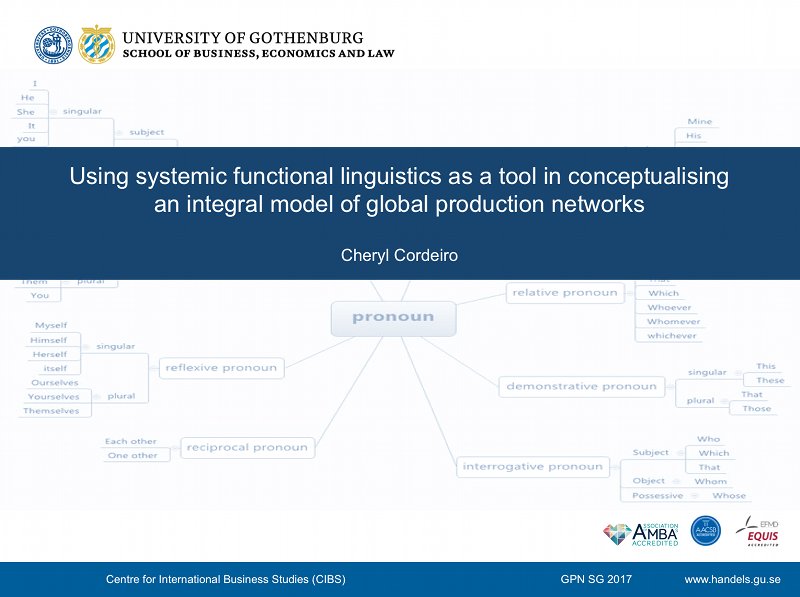
Hi everyone, my name is Cheryl Cordeiro, from the Centre for International Business Studies at the business school of the University of Gothenburg. My presentation today is about,
Using systemic functional linguistics (SFL) as a tool in conceptualising an integral model of global production networks (GPNs)
Just a brief introduction to my academic background because this submission is for the track theme Methodology in the study of global production networks. I have a PhD in general linguistics, and have academic background in information studies and language science. Most of my research focuses on applied linguistics, and language as a social semiotic. In particular, I’m interested in systemic functional linguistics (SFL) and its applications as theory and framework of analysis. Language is its own meta-language, and you could describe SFL as a general theory of the architecture of language in the study of not just what is said but how it is said. Language is its own meta-language in the sense too that you can use language to study language, but you can also use language to study other subjects, in this particular presentation, it is to model a general theory of global production networks.
[slide 2]
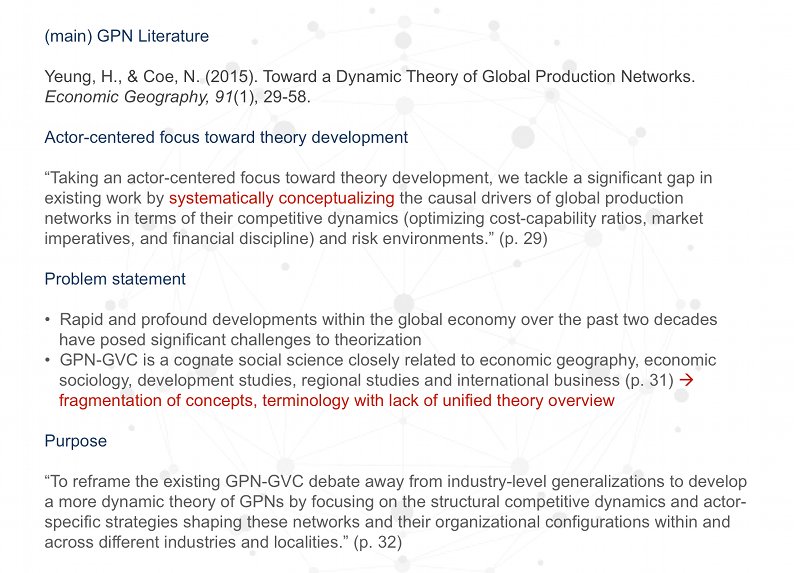
The main literature for this presentation is the 2015 paper by Henry Yeung and Neil Coe. When focusing on general theories, what is needed is not just a broad overview of concepts of the field but a future direction in ideas of the field. So I found this to be particularly useful for illustrating if and how a language meta-theory perspective can be used to frame concepts from the GPN-GVC field, towards the same purpose of a dynamic model of GPN theory.
Some key points from their article are that the authors take an actor-centered approach to theory development, systematically conceptualizing the causal drivers of global production networks in terms of their competitive dynamics and risk environments.
And the reason why they did this was in order to address increasingly complexity in the field of study. So rapid developments within global economy in the past 2 decades have posed challenges to theorization. And here I would also add that this increase in development in global economy is certainly enabled by advancing communications technology, digital infrastructures and additive manufacturing as I will hope to show in my empirical case example in a few minutes.
Most disciplines have adjacent fields of study. GPN is also a cognate or related discipline to the following other disciplines that include economic geography, economic sociology, developmental studies, regional studies, IB studies. The advantage is that what is studied has broad base coverage. The disadvantage is that these related disciplines may not also share the same lingo. What results is fragmentation of concepts and most of all, there is no unified theory behind similar concepts, no single platform to which the majority of academics can begin discussion to bring forward the knowledge paradigm.
So the authors have tried to reframe existing GPN GVC debate from industry level generalizations to focus on actor-specific strategies that shape these network, within and across different industries and localities.
[slide 3]
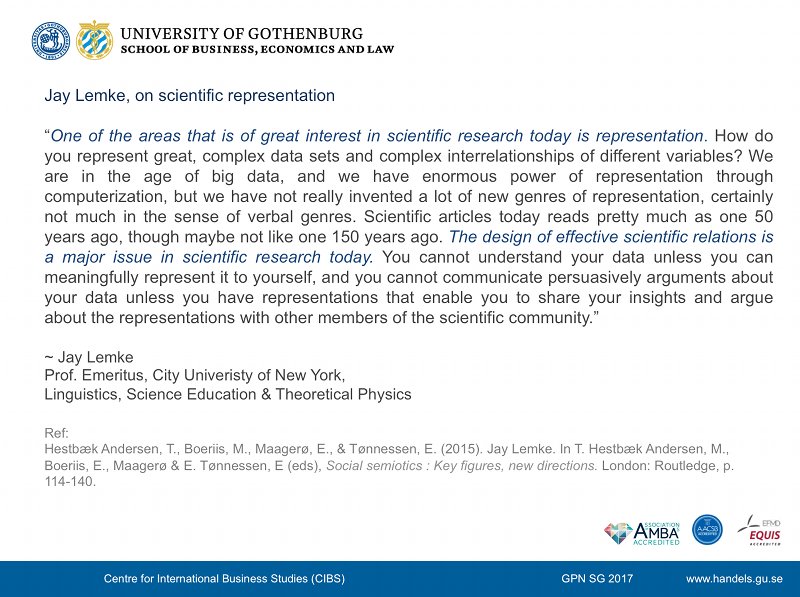
With that in mind, language scientists have also come to the same observation. In fact, Jay Lemke is also a theoretical physicist by academic background, and what is observed is, what is of greatest interest today for scientific research is representation. How do you represent great, complex data sets and complex interrelationships of different variables? In this era of big data, digital infrastructure, it seems like the academic genre of representing knowledge hasn’t changed so much in the past half century. The ability and capacity to represent data, findings, concepts, is increasingly important.
[slide 4]
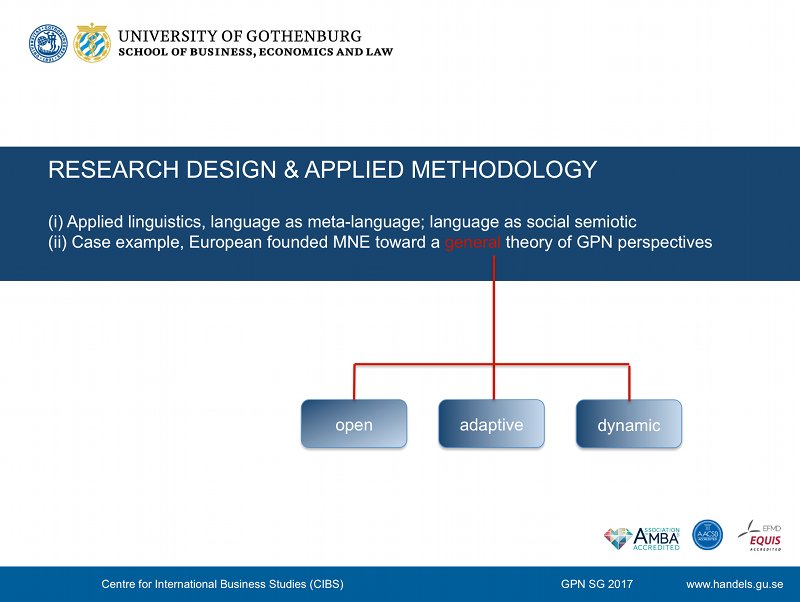
So we might all know this but haven’t as yet paid so much attention to it, because what is ubiquitous is usually taken for granted or made tacit. An example would be that we are often proficient at using language but we might not be so efficient at naming all the grammatical categories or rules explicitly for how we make meaning when we use language. In everything that we do, especially in research and the study of something, is to make sense out of it. To create meaning that is shared within a community, so language as a social semiotic. A GPN or GVC does not exist if there was no language in which to facilitate processes and create networks. Most of the time, language is not studied outside of linguistics as process and tool of communication, this presentation addresses this gap in literature by using applied linguistics towards a general model of GPN theory. And by ‘general’ (part ii) what is meant is that the theory is open, adaptive and dynamic, so that it can continue to explain the evolution of processes in the field of study.
[slide 5]
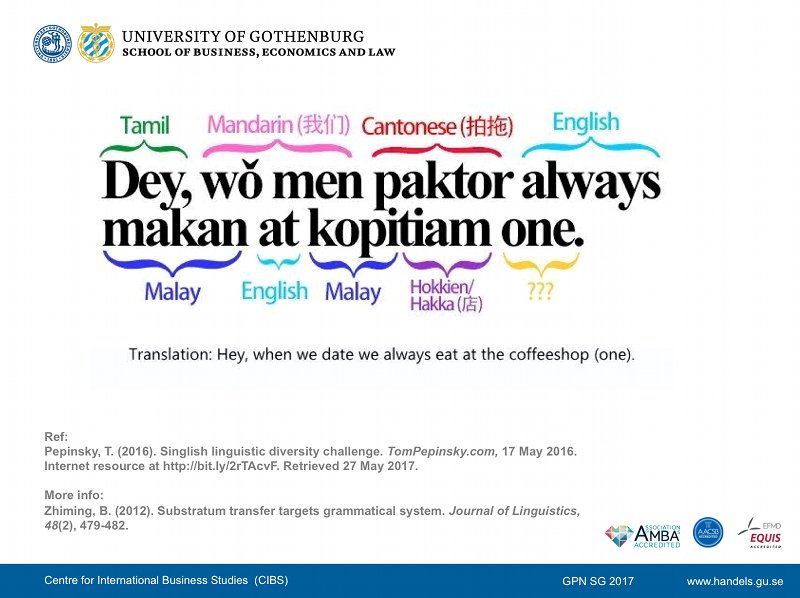
Language is actually an open, adaptive system. If we look at the example of Global New Englishes, where Singapore English has distinctly two different varieties, the colloquial and the standard variety, you’ll find that the colloquial variety is very much influenced at the lexical level by word borrowings, with an underlying Chinese grammar. Here’s a Singapore Colloquail English sentence construct with word borrowings from at least 3 different languages, with 3 different varieties from the Chinese language.
[slide 6]
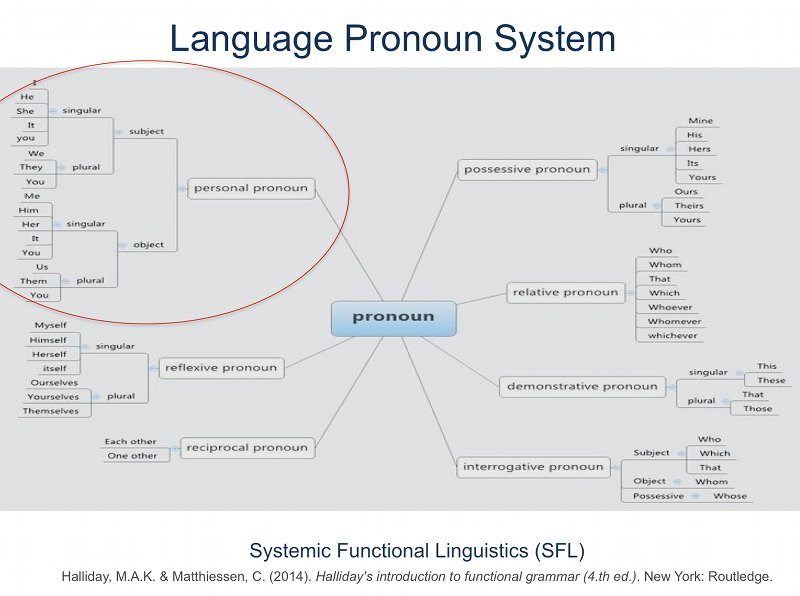
Back to the idea of an actor-cantered approach to theorising about GPN-GVCs, I don’t think anything can be more actor-cantered in approach than using the Pronoun System of Reference as provided by the system and architecture of language. So language is made up of many systems, and you will see some more systems of language example in the slides to come, but this diagram here illustrates the Pronoun system for the English language. What we’ll focus on here is just the Personal Pronoun part of the system, the one with the deictic or pointer function that indicates from whose perspective, I, You, We, They, It and Its.
[slide 7]
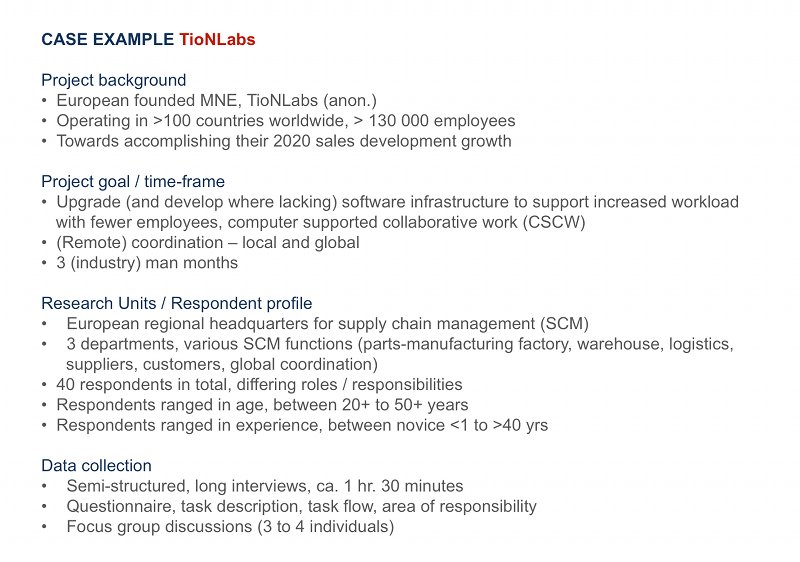
The example I’d like to share with you when applying the Pronoun Referencing System that also gives you the different perspectives of actors, activities and processes is the case example of TionLabs.
TionLabs is a created name for this project that was a real case example from a European founded multinational enterprise. This MNE is a global conglomerate, one of the largest in the world, operating in more than 100 countries with more than 135,000 employees. They have a 2020 vision of increasing productivity and in this particular division that manages one part of the MNE’s global production networks in supply chain management, they are also working on their strategy towards development growth.
There were 3 departments I worked with, these departments were interdependent in functions, so in terms of work flow, some processes needed to go through Dept. A and then it can be taken over by people at Dept. B and so on. There was a challenge already here with an overlap of portfolio, and when something went wrong, it was sometimes the situation of blaming people from the other department. There were 40 respondents across these departments in total and they ranged from between 20 to 50 years. So you can already see here, the potential gap in experience, and to what extent they were familiar with digital technologies. There were novices as well as those who had been in the organization for more than 40 years.
Data collection was via interviews, surveys, an individual task flow description and focus group discussions consisting of between 3-4 individuals at a time, so, team focus group discussions.
[slide 8]

To get started on their outlined development strategies, the first thing they wanted to do was to go through their current strengths. What they were managing looked pretty much like this diagram here. And they also had similar questions towards growth development. How to minimise cost with minimised labour input, how to accommodate expected work load increase, how to make more efficient the processes. So all the questions were familiar in that sense, except, now they were working in the context of
[slide 9]
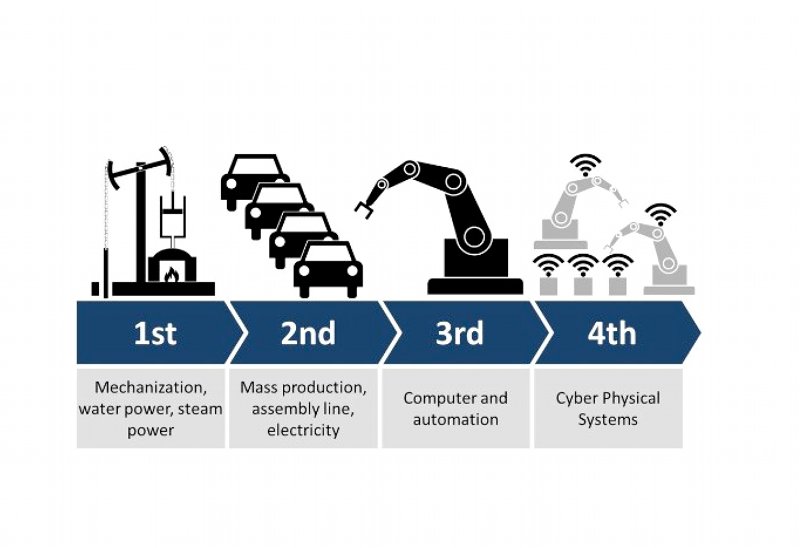
Industry 4.0. In fact this particular MNE could also be said to be driving the technologies of Industry 4.0, because they have different business units and their different BUs have different technological strengths and breakthroughs. Cyber physical systems is a real concept to them. That would be robots talking to robots with little or no human intervention. And with Industry 4.0, you also have this as reality…
[slide 10]

Remote services and expert engineers in suits, wearing for example, either an augmented reality (AR) lens, which isn’t quite developed yet, or virtual reality (VR) lens, which is what the industry is working with right now. So an expert engineer, need not be onsite in order to give instructions to a novice engineer to fix hardware problems.
[slide 11]
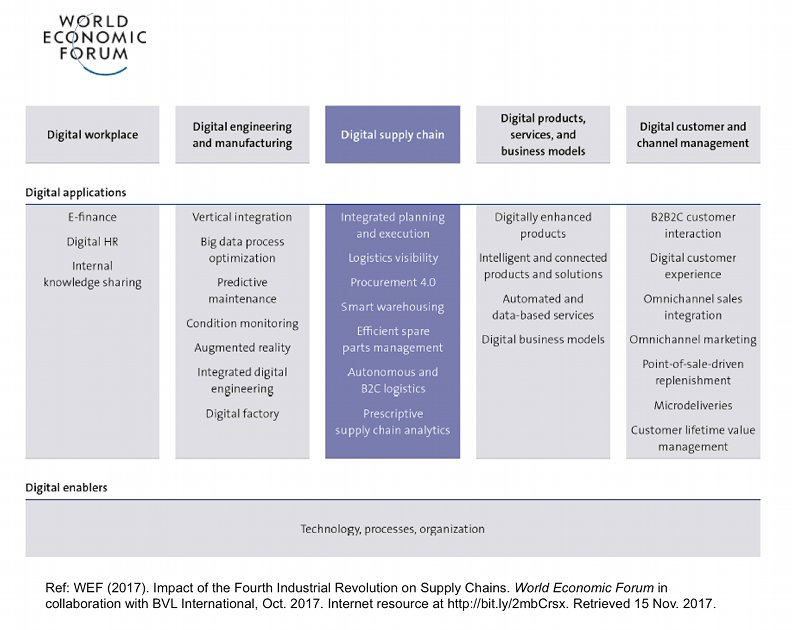
Because manufacturing processes and the products manufactured are going Smart or digitised, the group was highly aware that they needed to strengthen their digital infrastructure. This enterprise is in particular, is looking at smart factories where within a few years, it is quite possible that robots will be making robots, and all manufacturing controls will be supported by digital infrastructure.
Some effects of digital infrastructure is shown on this table here from WEF 2017.
A shared platform was being considered not just internally but also with external suppliers and customers. They had to improve remote coordination at both local site and global sites from part production to part delivery and stocks.
This initial project was given 3 man months towards completion, with the aim of sharpening and making more efficient, computer supported collaborative work.
[slide 12]
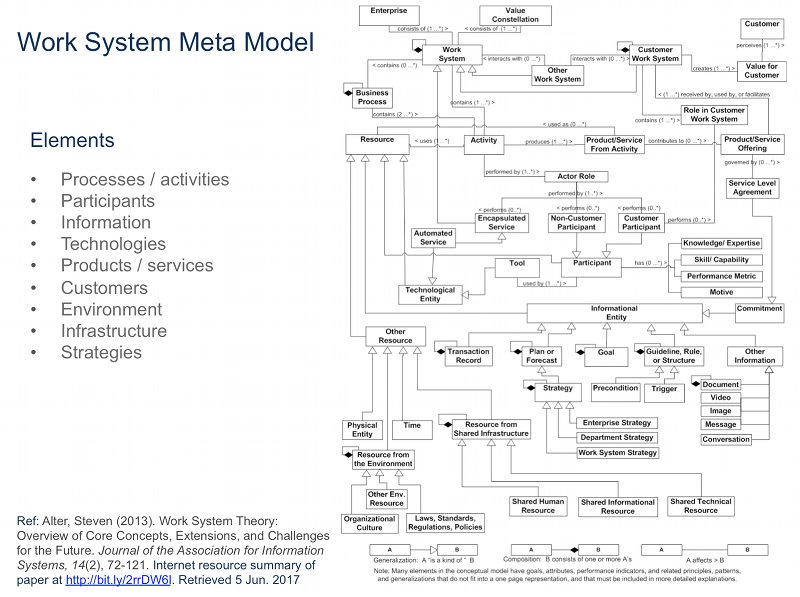
This chart here is an example of a Work System Meta- Model from Steven Alter’s 2013 journal article. It is however exactly what our software architect received from the departments as starting point for improvement. Steven Alter said in his article that it might look very complicated when you first look at it, but if studied some more, it is not that complicated. I guess that might be true, given Time. But Time is not exactly what we had with 3 man-months for this project. And some of the system back-end was dated back to the 1980s when computers first arrived at the enterprise. It was installed, the programs were configured and very little was done since then, as long as the system worked. The other challenge is the staff turnover or contract companies that created the system who were no longer around. There is a discontinuity of knowledge in the work system meta- model.
But if you look to the left hand side of the slide, you’ll see the elements of the work system meta- model. These elements are all interrelated and interdependent, and they are also the same elements reflected in GPN-GVC literature.
[slide 13]
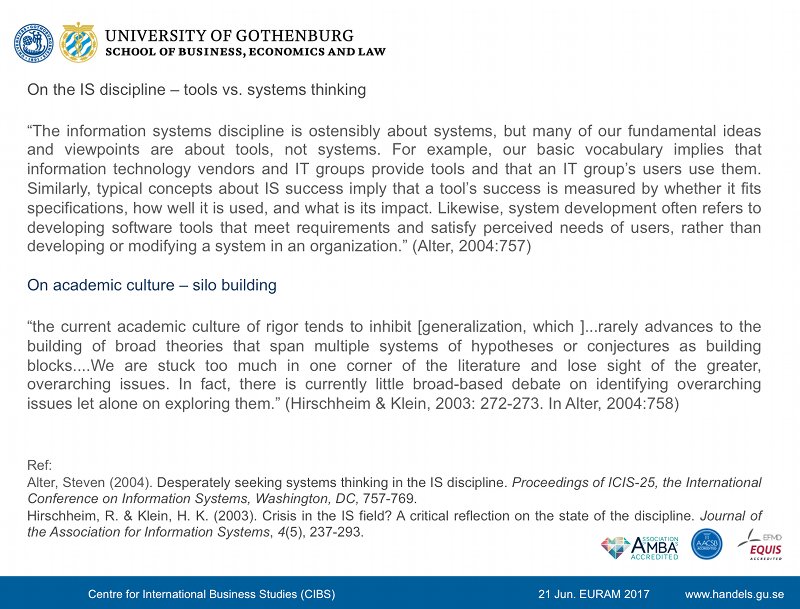
Now the work system meta- model and when you think about building digital infrastructures, what you’re thinking about is creating a system of tools. In these quotations here, Steven Alter points towards that most information science disciplines still think about digitalisation as tools, and not as systems. In the next quotation, it is the same with academic disciplines, that it is still the case that we look at each discipline as a ‘tool’ in its own silo, and not look further into the system of tools, the system of the broader knowledge paradigm and where that’s taking humanity in the near future. The reason why the greater call for general theories or unified theories, dynamic theories, theories that can now conceptualise over broader views.
[slide 14]
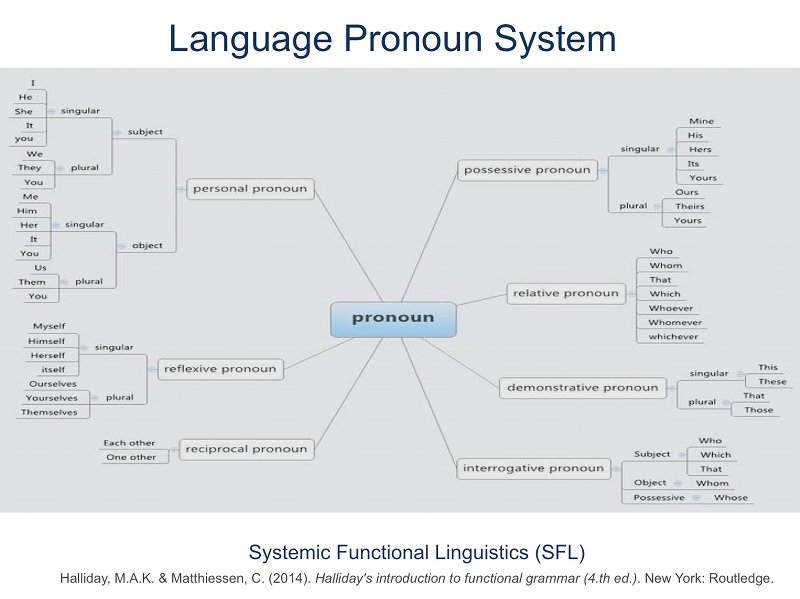
This ties back to language as a meta-language, and language as an open, adaptive system, bringing us back to how language can help build a general GPN theory. And as a side note, you might also notice that language Pronoun Referencing System now resembles the work system meta- model of the previous slide, maybe a little neater. But what is visualised here with language as a social semiotic, meaning a tool that can be used to make meaning.
[slide 15]
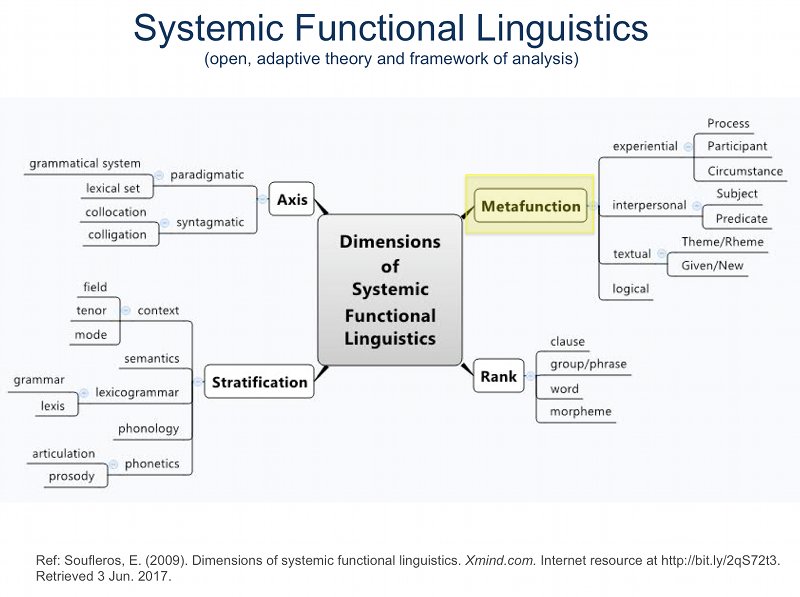
This manner of studying the Pronoun Referencing System in language is through the framework of Systemic Functional Linguistics. It is a functional view of language where the paradigmatic choices are foregrounded. The grammar that I grew up with when taught in schools would have foregrounded the syntagmatic (linear) structure.
In this slide, you can see that language metafunctions are what you can use to study the elements of the work system meta-model, and where you can also slot in elements from GPN-GVC theories, because metafunctions uncover actors in relationships and the circumstance, the context within these relationships take place.
[slide 16]
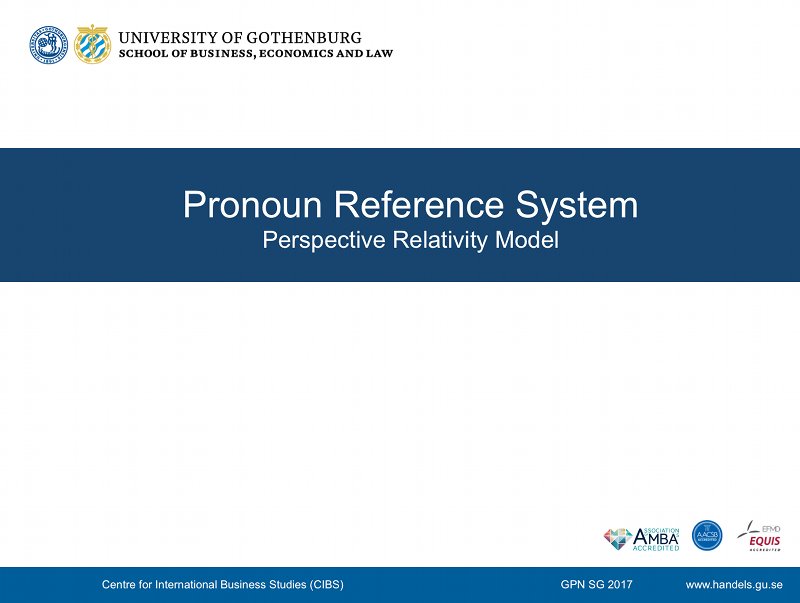
What the Pronoun Referencing System does is to systematise perspectives in relativity.
[slide 17]

This is the visualisation of the Pronoun Referencing System, beginning only with the personal pronouns, illustrating singular subjective (I), plural intersubjective (We), singular objective (It) and plural interobjective (Its). This might seem mundane but it is important because each quadrant is much more than the pronouns. When you consistently make inquiries from a consistent perspective, you start to build methods pertaining to that perspective, and you start to build a body of knowledge related to that perspective. In a way, that’s how academic silos are built, reflected in their different methodologies and different fields of study.
[slide 18]
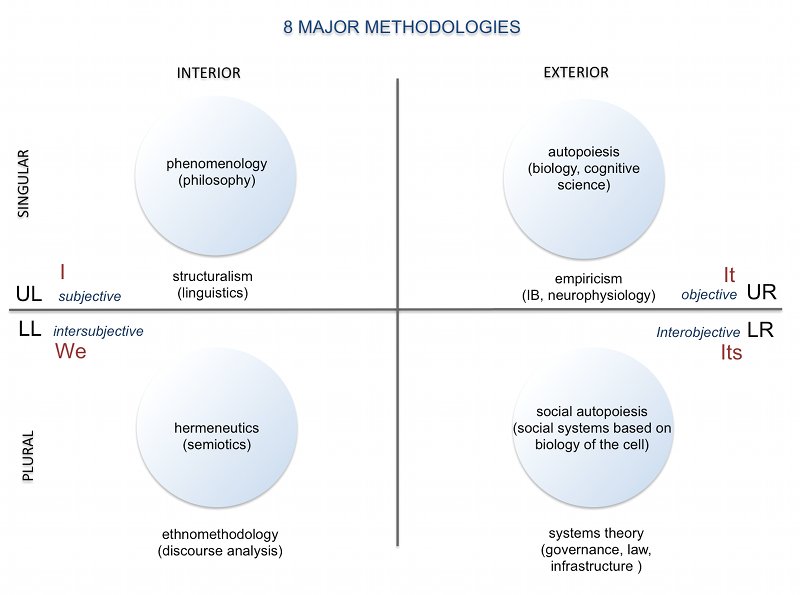
Here is a map of the 8 primordial methodologies and what types of knowledge they render. You will also recognise that certain disciplines are biased towards certain types of methods, these methods can be mapped into these four quadrants. The reason for this diagram is to illustrate the common denominator of how language is meta-theory and how it structures all other types of knowledges. So if you’re looking for an open, adaptive theory, language could well be that underlying framework upon which to base your general theory.
[slide 19]

A reminder here about the elements of the work system meta model. Also the elements of a GPN-GVC.
[slide 20]
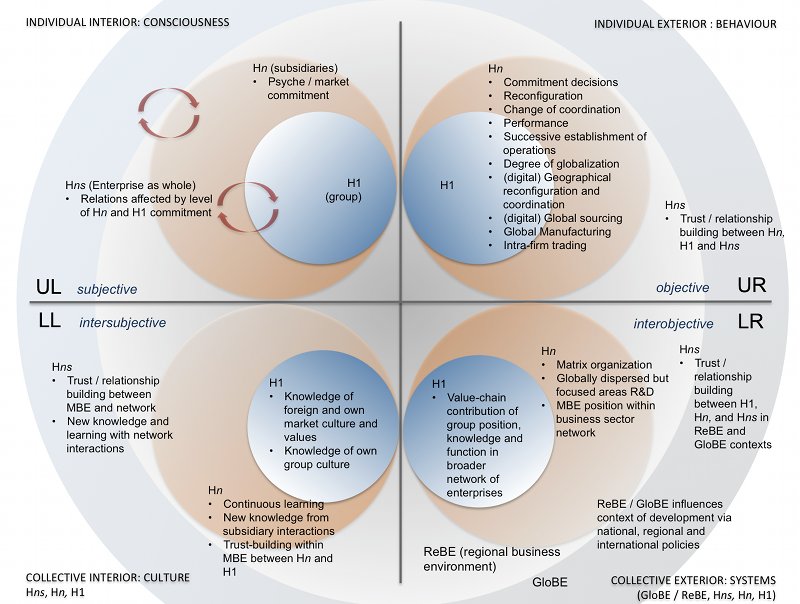
Now mapped unto the Pronoun Referencing System found in language. These elements listed here in the four quadrants are part findings of the case example of TionLabs. If you are talking about actor-centrered theories, then in this visualisation, you can most certainly see, down to the exact group dynamics of the enterprise, causation relationships. A close example would be enterprise psyche and commitment from top managers, to department managers. If there was no commitment (usually indicated first and foremost financially, by internal budgeting) from the top management, then there would be no digital infrastructure built, and there would simply be no digitalisation of the global supply chain management system. But having enterprise commitment is not the only thing, because new digitalisation system of tools means re-learning from some very experienced staff and staff who are almost about to retire. What would incentivise them to learn a completely new way of doing something they have done well for the past 40 years? So you need individual commitment to the group effort. Individuals are very small but powerful fulcrums to the workings of a GPN-GVC. From the broader perspective, you can then look into standardisation of systems, regionally and globally. How about industry standardisation? Etc. That type of studies are located in the lower right quadrant.
So this model is a research design and general theoretical framework that can be applied to various fields of study. In this case, toward a dynamic, general GPN theory.
[slide 21]

Last take home point, is to reiterate a quote from Jay Lemke. That it is the design of effective scientific relations that is the major issue of science today. You need to understand your data, and you can do it if you can meaningfully represent it, like a map towards a destination.
[slide 22]

Thank you for your time and for listening.
References
[1] HKTDC (2013). New Measurement for Global Trade: Economist Dr Patrick Low. Internet resource at https://youtu.be/_sMapok9O1c. Retrieved 16 Dec. 2017.
[2] Low, P. (2016). R.I.P. TPP, time to turn back to the WTO, Nikkei Asian Review, 26 Dec. 2016. Internet resource at http://s.nikkei.com/2ClnY0n. Retrieved 16 Dec. 2017.
[3] Møller, J. Ø. (2017). Interdisciplinary and holistic education and research, Future-ready Universities and Graduates: Quality Education Beyond the Horizon, 6th ASEF Rectors’ Conference and Students’ Forum #ARC6. Internet resource at http://bit.ly/2vXKZqD. Retrieved 16 Dec. 2017.
